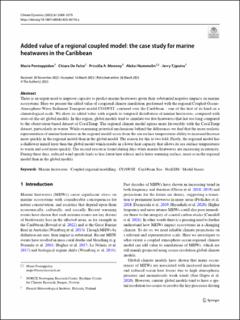| dc.contributor.author | Pontoppidan, Marie | |
| dc.contributor.author | De Falco, Chiara | |
| dc.contributor.author | Mooney, Priscilla A. | |
| dc.contributor.author | Nummelin, Aleksi Henrynpoika | |
| dc.contributor.author | Tjiputra, Jerry | |
| dc.date.accessioned | 2023-09-20T07:53:41Z | |
| dc.date.available | 2023-09-20T07:53:41Z | |
| dc.date.created | 2023-04-24T11:45:12Z | |
| dc.date.issued | 2023 | |
| dc.identifier.citation | Climate Dynamics. 2023, . | en_US |
| dc.identifier.issn | 0930-7575 | |
| dc.identifier.uri | https://hdl.handle.net/11250/3090673 | |
| dc.description.abstract | There is an urgent need to improve capacity to predict marine heatwaves given their substantial negative impacts on marine ecosystems. Here we present the added value of a regional climate simulation, performed with the regional Coupled-Ocean–Atmosphere-Wave-Sediment Transport model COAWST, centered over the Caribbean – one of the first of its kind on a climatological scale. We show its added value with regards to temporal distribution of marine heatwaves, compared with state-of-the-art global models. In this region, global models tend to simulate too few heatwaves that last too long compared to the observation-based dataset of CoralTemp. The regional climate model agrees more favourably with the CoralTemp dataset, particularly in winter. While examining potential mechanisms behind the differences we find that the more realistic representation of marine heatwaves in the regional model arises from the sea surface temperatures ability to increase/decrease more quickly in the regional model than in the global model. The reason for this is two fold. Firstly, the regional model has a shallower mixed layer than the global model which results in a lower heat capacity that allows its sea surface temperatures to warm and cool more quickly. The second reason is found during days when marine heatwaves are increasing in intensity. During these days, reduced wind speeds leads to less latent heat release and a faster warming surface, more so in the regional model than in the global models. | en_US |
| dc.language.iso | eng | en_US |
| dc.rights | Navngivelse 4.0 Internasjonal | * |
| dc.rights.uri | http://creativecommons.org/licenses/by/4.0/deed.no | * |
| dc.title | Added value of a regional coupled model: the case study for marine heatwaves in the Caribbean | en_US |
| dc.title.alternative | Added value of a regional coupled model: the case study for marine heatwaves in the Caribbean | en_US |
| dc.type | Peer reviewed | en_US |
| dc.type | Journal article | en_US |
| dc.rights.holder | © The Author(s) 2023 | en_US |
| dc.description.version | publishedVersion | en_US |
| cristin.ispublished | true | |
| cristin.fulltext | original | |
| cristin.qualitycode | 2 | |
| dc.identifier.doi | 10.1007/s00382-023-06758-y | |
| dc.identifier.cristin | 2142832 | |
| dc.source.journal | Climate Dynamics | en_US |
| dc.source.pagenumber | 11 | en_US |
| dc.relation.project | Sigma2: NN1002K | en_US |
| dc.relation.project | Sigma2: NS1002K | en_US |
| dc.relation.project | Norges forskningsråd: 295340 | en_US |
| dc.relation.project | EC/H2020/817578 | en_US |
| dc.relation.project | Norges forskningsråd: 318477 | en_US |
| dc.relation.project | Norges forskningsråd: 322912 | en_US |

